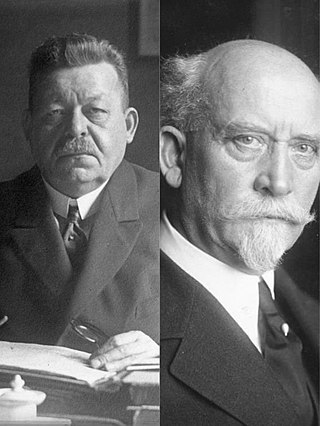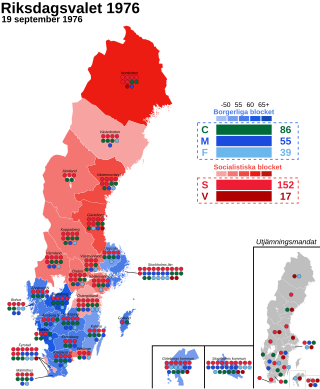
Federal elections were held in Germany on 19 January 1919, although members of the standing army in the east did not vote until 2 February. The elections were the first of the new Weimar Republic, which had been established after World War I and the Revolution of 1918–19, and the first with women's suffrage. The previous constituencies, which heavily overrepresented rural areas, were scrapped, and the elections held using a form of proportional representation. The voting age was also lowered from 25 to 20. Austrian citizens living in Germany were allowed to vote, with German citizens living in Austria being allowed to vote in the February 1919 Constitutional Assembly elections.

General elections were held in Sweden on 17 and 18 September 1932. The Swedish Social Democratic Party remained the largest party, winning 104 of the 230 seats in the Andra kammaren of the Riksdag. The party returned to government after six years in opposition, marking the beginning of 44 years of near-uninterrupted rule. This was also the first time the socialist parties received an overall majority of the elected parties' popular vote, although the Hansson cabinet still required cross-aisle co-operation to govern since the centre-right parties won 118 out of 230 seats.

General elections were held in Sweden on 20 September 1964. The Swedish Social Democratic Party remained the largest party, winning 113 of the 233 seats in the Andra kammaren of the Riksdag. Tage Erlander's Social Democratic government was returned to power.

General elections were held in Sweden on 15 September 1968. Held in the wake of the crushing of the Prague spring, it resulted in a landslide victory for the Social Democratic government and Prime Minister Tage Erlander. It is one of two general elections in Swedish history where a single party received more than half of the vote. Erlander would resign the following year after an uninterrupted tenure of 23 years as head of government.

General elections were held in Sweden on 19 September 1976. Although the Swedish Social Democratic Party remained the largest party, winning 152 of the 349 seats in the Riksdag, a coalition government was formed with the Centre Party, the People's Party and the conservative Moderate Party, which formed Sweden's first non-socialist government since 1936. Centre Party leader Thorbjörn Fälldin, who had widely been expected to take over the government in the previous election of 1973, was appointed Prime Minister, the first not from the Swedish Social Democratic Party since Axel Pehrsson-Bramstorp's brief interregnum 40 years earlier.

General elections were held in Sweden on 15 September 1985. The Swedish Social Democratic Party remained the largest party in the Riksdag, winning 159 of the 349 seats. Its leader, Olof Palme, kept his position as Prime Minister. He would retain this position successfully until his assassination in 1986.

Parliamentary elections were held in Hungary on 10 May 1998, with a second round of voting in 175 of the 176 single member constituencies on 24 May.

Early general elections were held in Sweden between 27 March and 7 April 1914, after the Riksdag had been prematurely dissolved by the Cabinet of Hjalmar Hammarskjöld. The General Electoral League emerged as the largest party, winning 86 of the 230 seats in the Second Chamber. As of 2022, this is the last time a Swedish election has not seen the Social Democrats win a plurality of seats.

Early general elections were held in Sweden 5 and 13 September 1914, the second that year. Although the General Electoral League received the most votes, the Swedish Social Democratic Party emerged as the largest party, winning 87 of the 230 seats in the Second Chamber, and have managed to remain so in every subsequent Swedish election.
Sweden held a general election on 15 September 1968, to elect the members of the Second chamber of the Riksdag. This was to be the final bicameral Riksdag elected. As of 2020, this was the final time a party has held an outright majority in the Riksdag after the Social Democrats won 125 out of the 233 seats.
Sweden held an early general election to fulfil the four-year term between the regular 1956 and 1960 elections. Although the centre-right received more votes, the leftist parties won one more seat. The election was held on 1 June.
Sweden held a general election on 16 September 1956. This was the sole election between WWII and 1976 which rendered a centre-right majority in the chamber, although the bicameral system and the majority for the leftist parties in the upper chamber rendered a cross-coalition Social Democrat-Farmers' League government.
Sweden held a general election on 19 September 1948. This was Sweden's first election since the 1945 dissolution of the wartime unity cabinet consisting of the Social Democrats and all three centre-right parties. The election saw the Social Democrats remain at 46%, enough to remain in government. The centre-right parties gained ground at the relative cost of the Communists, who fell back by quite a bit in the overall vote. The People's Party had the biggest gains of any party, becoming the largest member of the opposition.
Sweden held a general election on 17 September 1944. Due to the wartime coalition government the bloc balance mainly determined that Per-Albin Hansson remained as Prime Minister, with the four-party coalition remaining in office with 215 out of 230 seats. Among the traditional blocs, the left bloc won 130 and the right bloc 100.
Sweden held a general election on 15 September 1940.
Sweden held a general election around 19 September 1924. This was the second election under universal suffrage. In spite of a majority for the non-socialist parties, Social Democrat Hjalmar Branting was able to form a government, although his successor eventually saw the government fall and being replaced by a right-leaning Electoral League government.
Sweden held a general election around 15 September 1928 to the second chamber.
Sweden held a general election around 17 September 1932.
Sweden held a general election throughout September 1921.
Sweden held a general election in September 1920. The election was the last before universal suffrage was introduced the following year. The Social Democratic Party remained the largest party, winning 75 of the 230 seats in the Second Chamber of the Riksdag. In spite of this, the non-socialist parties got a sizeable majority in the chamber.







